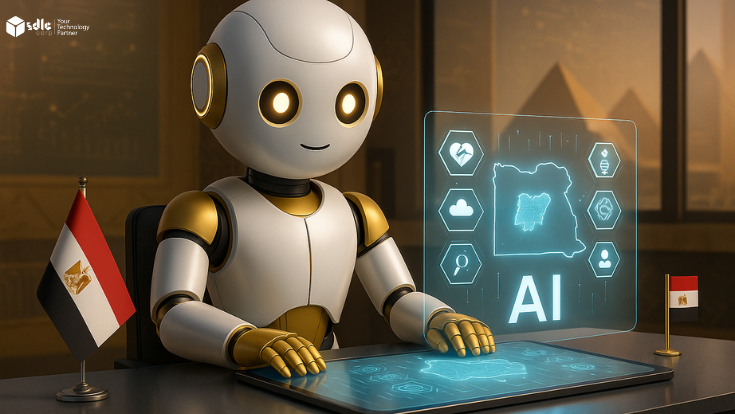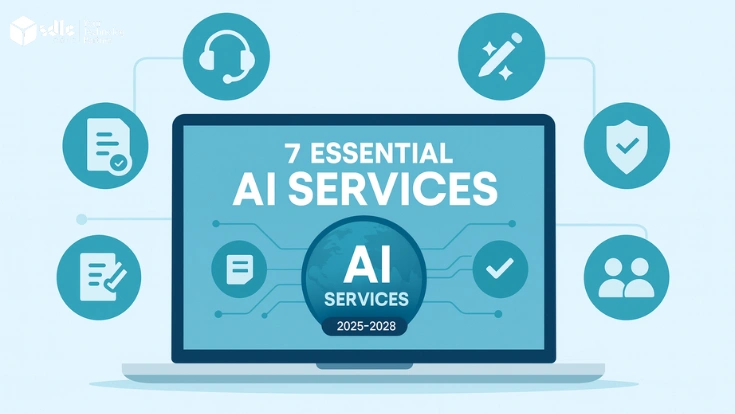Introduction
AI for HealthTech represents the powerful integration of artificial intelligence with healthcare innovation, transforming how medical professionals diagnose, treat, and manage patient care. As global adoption accelerates, the AI for HealthTech market is projected to surpass billions in value driven by the growing demand for precision, efficiency, and personalized medicine. With AI development services and custom AI solutions, healthcare providers and innovators can harness the power of data-driven intelligence to enhance diagnostics, automate operations, and improve patient outcomes.
From AI-powered diagnostic tools that boost accuracy to robotic surgeries that improve recovery, predictive analytics anticipating health risks, and clinical decision support optimizing workflows AI for HealthTech is revolutionizing the industry. By leveraging these advancements, healthcare organizations can deliver smarter, more efficient, and patient-centric care while driving innovation across global medical systems.
1. Foundations of AI for Healthtech
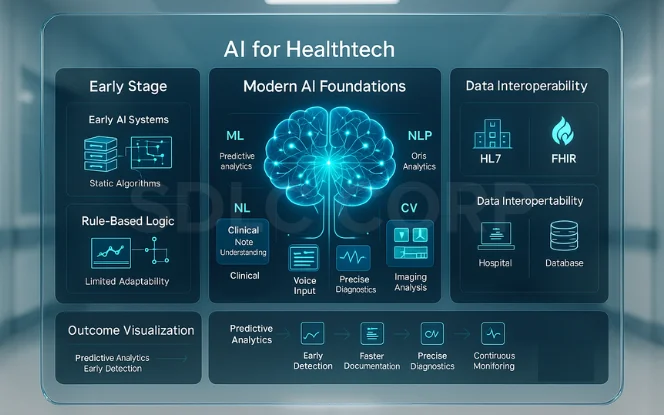
AI for Healthtech has evolved from early rule-based expert systems to sophisticated deep learning models that mimic human cognition. Initially, healthcare relied on static algorithms and decision trees, but today’s AI for Healthtech solutions use neural networks and vast datasets to enhance accuracy, speed, and personalization in clinical care. This rapid transformation highlights the synergy between technological progress and the growing need for intelligent, data-driven healthcare delivery.
Evolution and Core Components
The foundation of AI for Healthtech rests on three major technological pillars:
- Machine Learning (ML): Enables predictive analytics to identify disease risks and treatment outcomes.
- Natural Language Processing (NLP): Helps in understanding unstructured clinical notes, improving documentation, and enabling voice-driven interfaces.
- Computer Vision (CV): Powers image-based diagnostics in radiology, pathology, and dermatology with unprecedented precision.
- IoMT (Internet of Medical Things): Integrates connected devices for real-time monitoring and remote patient management.
Read More : Generative AI for Healthtech
Data Requirements and Interoperability
To operate effectively, AI for Healthtech depends on high-quality, standardized, and interoperable data. Frameworks like HL7 and FHIR ensure smooth data exchange between devices, systems, and applications—creating a cohesive digital ecosystem that supports scalable AI models.
Technology vs. Healthcare Function Table
| Ethical Issue | Risk | Mitigation |
|---|---|---|
| Data bias | Unfair assessments | Regular audits |
| Privacy breaches | Data exposure | Encryption & anonymization |
| Lack of transparency | Loss of trust | Explainable AI models |
AI for Healthtech continues to redefine how professionals deliver care, blending innovation with accessibility to create smarter, patient-centered healthcare systems.
2. Core Applications of AI for Healthtech
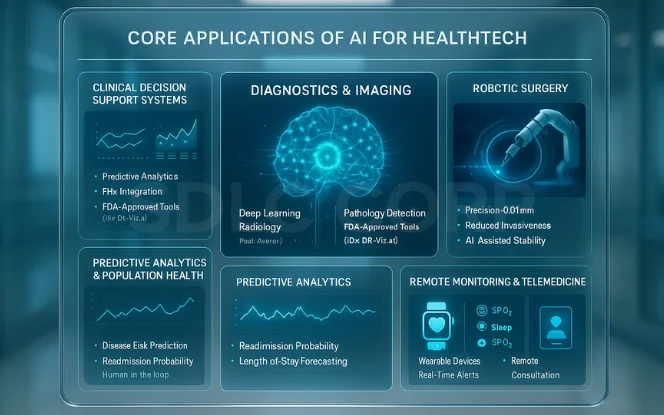
AI for Healthtech has become the backbone of digital transformation in healthcare. Its applications extend across diagnostics, clinical decision-making, robotic surgery, predictive analytics, and telemedicine redefining how medical professionals deliver patient care. The following sections outline the core use cases where AI for Healthtech demonstrates remarkable potential and measurable impact.
AI in Diagnostics and Medical Imaging
The use of AI for Healthtech in diagnostics and medical imaging has transformed clinical precision and efficiency. Through deep learning algorithms, AI can now analyze complex medical images—such as X-rays, MRIs, and CT scans—with accuracy comparable to expert radiologists.
- Radiology and Pathology: Deep neural networks detect tumors, fractures, or lesions that human eyes may overlook.
- FDA-approved AI systems: Tools like IDx-DR for diabetic retinopathy and Viz.ai for stroke detection exemplify regulatory trust.
- Workflow integration: Automated image triage helps radiologists focus on high-priority cases, reducing delays.
Furthermore, AI for Healthtech enhances early disease detection, minimizing human error and improving diagnostic confidence. By combining computational power with medical expertise, it enables faster, more consistent outcomes transforming diagnostics into a proactive rather than reactive field.
AI in Clinical Decision Support Systems (CDSS)
AI for Healthtech empowers Clinical Decision Support Systems (CDSS) to transform vast data into actionable intelligence. These systems leverage predictive and prescriptive AI to assist clinicians in making evidence-based decisions.
- Predictive analytics: Identifies risk patterns, such as sepsis or cardiac arrest, before symptoms escalate.
- EHR integration: Seamlessly connects with patient records, providing real-time alerts and treatment recommendations.
- Human-in-the-loop explainability: Maintains physician oversight while ensuring AI transparency and accountability.
As a result, clinicians experience reduced cognitive load and enhanced diagnostic accuracy. By integrating AI for Healthtech into daily workflows, hospitals can minimize preventable errors and standardize patient care quality across teams.
AI-Driven Robotic Surgery
AI-driven robotic surgery represents one of the most revolutionary applications of AI for Healthtech. These systems combine autonomous and semi-autonomous robotic arms with advanced image recognition and motion prediction.
- Precision and safety: Sub-millimeter accuracy minimizes tissue damage.
- Reduced invasiveness: Smaller incisions result in faster patient recovery and shorter hospital stays.
- Enhanced surgeon support: Robots can replicate stable, fatigue-free movements during long procedures.
For example, the da Vinci Surgical System uses AI-enhanced robotics to perform complex surgeries with improved precision. With AI for Healthtech, robotic platforms continuously learn from past surgeries, refining performance and elevating surgical standards globally.
Predictive Analytics & Population Health AI
The power of predictive analytics within AI for Healthtech enables early intervention and better population health management. By analyzing large-scale clinical and demographic data, AI models predict potential health risks long before they manifest.
- Early intervention models: Detect chronic disease risks like diabetes, COPD, and heart failure.
- Readmission prediction: Identifies patients at high risk of returning to the hospital.
- Length-of-stay forecasting: Helps optimize bed allocation and resource utilization.
Hospitals use these insights to personalize treatment, reduce readmission rates, and enhance operational efficiency. Ultimately, AI for Healthtech transforms healthcare from reactive treatment to proactive prevention—improving community health outcomes and cost savings simultaneously.
Remote Monitoring and Telemedicine
Remote care is the future of modern medicine, and AI for Healthtech plays a central role in powering telemedicine and remote patient monitoring systems. With wearable sensors and AI edge processing, clinicians can access real-time health data for continuous patient engagement.
- Wearable monitoring: Devices track heart rate, oxygen saturation, and sleep quality.
- Proactive alerts: AI algorithms detect abnormalities and send immediate notifications to care teams.
- Patient empowerment: Personalized feedback encourages preventive action and self-care.
AI-enabled telehealth platforms bridge geographical gaps, making healthcare accessible to underserved regions. Moreover, AI for Healthtech ensures consistent, data-driven monitoring—reducing emergency visits while improving long-term patient outcomes.
Key Takeaway
From diagnostics to remote monitoring, AI for Healthtech enhances every touchpoint of the patient journey. By integrating deep learning, predictive modeling, and automation, it enables healthcare systems to deliver faster, safer, and more personalized care. As the field continues to evolve, its influence will only expand empowering clinicians, improving patient satisfaction, and shaping the future of global healthcare.
Learn More About : Generative AI for Healthcare
3. Benefits of AI for Healthtech
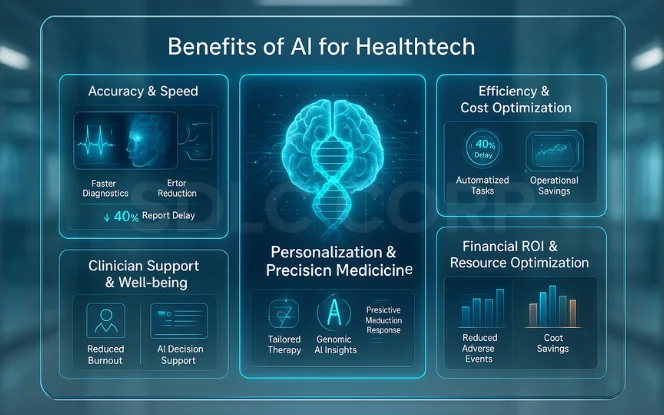
The implementation of AI for Healthtech has reshaped modern healthcare, introducing a new era of precision, efficiency, and personalization. By combining advanced analytics, automation, and intelligent algorithms, it empowers clinicians to deliver faster diagnoses, streamline workflows, and enhance patient outcomes.
Accuracy & Speed
AI for Healthtech enhances diagnostic accuracy and speed by analyzing complex datasets in seconds. Its deep learning algorithms minimize human error and improve clinical precision.
- Faster diagnostics: Reduces report turnaround time for imaging and lab results.
- Error reduction: Detects subtle anomalies invisible to the human eye.
- Outcome: More reliable, data-driven medical decisions.
Efficiency & Cost Optimization
Automation is one of the strongest advantages of AI for Healthtech, optimizing hospital operations and administrative workflows.
- Automated EHR tasks: Streamlines data entry and patient documentation.
- Operational savings: Cuts costs by reducing manual workloads.
- Outcome: Better resource utilization and smoother clinical coordination.
Personalization & Precision Medicine
By integrating genomic AI, AI for Healthtech enables personalized therapies based on genetic and lifestyle factors.
- Tailored treatment plans: Improves drug efficacy and reduces side effects.
- Predictive analytics: Identifies optimal medication for each patient.
- Outcome: Higher treatment success rates and patient satisfaction.
Clinician Support & Well-being
Automation tools assist clinicians in focusing on what truly matters—patient care.
- Reduced burnout: Minimizes repetitive administrative tasks.
- Decision support: Offers AI-driven recommendations for complex cases.
- Outcome: Enhanced productivity and physician satisfaction.
Financial ROI & Resource Optimization
AI for Healthtech also drives measurable financial returns for healthcare systems.
- Reduced adverse events: Fewer complications and readmissions lower costs.
- Optimized resource use: Predictive models improve scheduling and inventory.
- Outcome: Sustainable profitability and long-term growth.
AI for Healthtech delivers transformative value—boosting accuracy, efficiency, personalization, and financial sustainability. By empowering clinicians and optimizing care delivery, it lays the foundation for a smarter, data-driven future in healthcare.
4. Challenges and Regulatory Concerns in AI for Healthtech
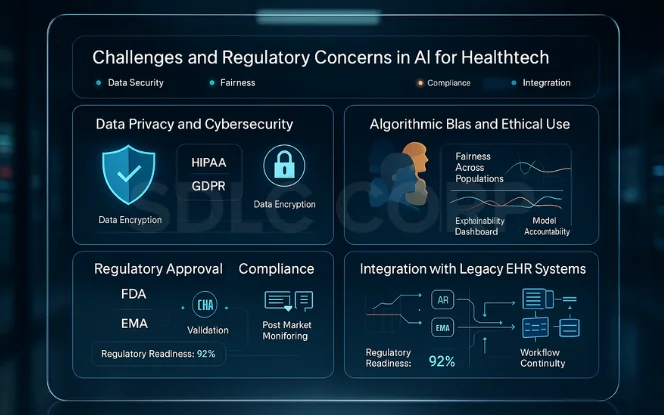
As the adoption of AI for Healthtech accelerates worldwide, healthcare organizations face a range of regulatory, ethical, and operational challenges. Balancing innovation with compliance and trust is vital to ensure responsible use of AI in clinical settings.
Data Privacy and Cybersecurity
AI for Healthtech relies on vast amounts of patient data, making privacy and data protection a primary concern. Strict regulations such as HIPAA (Health Insurance Portability and Accountability Act) and GDPR (General Data Protection Regulation) govern how sensitive health data must be collected, stored, and shared.
- Cybersecurity risks: AI systems are vulnerable to hacking and data breaches.
- Compliance obligations: Organizations must implement encryption and access control.
- Data integrity: Real-time validation prevents tampering and ensures trustworthiness.
Algorithmic Bias and Ethical Use
Bias within AI models can lead to unfair or inaccurate medical predictions, particularly across diverse demographics. Ensuring ethical AI for Healthtech requires transparency, continuous auditing, and diverse datasets.
- Fairness: Models must represent all population groups equitably.
- Explainability: Clinicians need interpretable outputs to make informed decisions.
- Accountability: Developers and institutions share responsibility for ethical outcomes.
Regulatory Approval and Compliance
Before clinical deployment, AI algorithms must meet stringent approval standards from FDA and EMA.
- Rigorous validation: Models must prove safety, efficacy, and reproducibility.
- Post-market surveillance: Continuous updates and monitoring are required.
- Documentation: Proper regulatory filings ensure transparency and trust.
Integration with Legacy EHR Systems
Many healthcare providers still depend on legacy EHR (Electronic Health Record) systems, which can hinder seamless AI adoption.
- Interoperability issues: Legacy systems may lack HL7/FHIR compatibility.
- Workflow disruption: Integration failures can reduce clinician efficiency.
- Solution: Implement APIs and modular frameworks for smoother connectivity.
To overcome these barriers, organizations should implement strong healthcare AI governance frameworks. This ensures compliance, fairness, and sustainable growth while preserving patient trust.
Explore More : AI for Healthcare
5. Implementation Strategy for AI in Healthcare
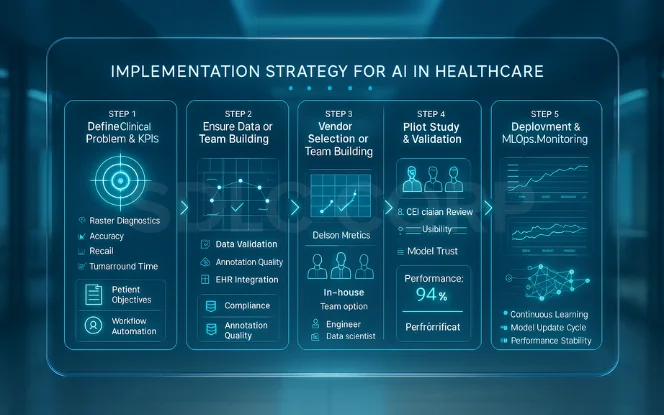
Implementing AI for Healthtech demands a systematic and well-structured approach that bridges clinical needs with technological innovation. To ensure success, healthcare organizations must define clear goals, use quality data, validate performance, and continuously monitor outcomes. With the right roadmap, AI for Healthtech can improve efficiency, accuracy, and patient outcomes while maintaining compliance and transparency.
Step 1: Define Clinical Problem & KPIs
The foundation of AI adoption begins with identifying the clinical challenge and establishing measurable Key Performance Indicators (KPIs). This ensures that the technology addresses real-world healthcare pain points.
- Define the clinical objective (e.g., diagnosis, workflow automation).
- Set KPIs such as accuracy, recall, precision, and turnaround time.
- Align objectives with patient safety and institutional goals.
Step 2: Ensure Data Quality & Annotation
AI for Healthtech thrives on clean, well-annotated data. Poor-quality data can lead to biased or unreliable models.
- Validate data sources for accuracy and completeness.
- Standardize annotation processes to ensure consistency.
- Use structured (EHRs) and unstructured (clinical notes) data effectively.
Step 3: Vendor Selection or Team Building
Choosing the right implementation model ensures long-term scalability.
- Select reputable AI vendors with proven healthcare experience.
- Build in-house teams combining clinicians, data scientists, and engineers.
- Evaluate solutions based on compliance, scalability, and interoperability.
Step 4: Pilot Study & Validation
Before full-scale deployment, run a pilot project to validate performance.
- Use metrics like AUC, recall, and specificity for evaluation.
- Gather clinician feedback for real-world usability.
- Adjust algorithms based on validation outcomes.
5: Deployment & MLOps Monitoring
Successful AI integration requires robust operational support.
- Deploy through MLOps frameworks to enable continuous monitoring.
- Regularly retrain models using updated datasets.
- Track performance drift and maintain explainability.
Implementation Checklist
To ensure sustainable success of AI for Healthtech initiatives:
- Regulatory compliance: Meet HIPAA/GDPR standards.
- Clinician training: Support adoption through proper education.
- Bias auditing: Detect and mitigate algorithmic bias.
- ROI tracking: Measure cost-effectiveness and clinical value.
By following these structured steps and maintaining transparency throughout the process, AI for Healthtech can deliver measurable improvements in care quality, efficiency, and innovation—paving the way for a smarter, more connected healthcare ecosystem.
Read More : HOW MUCH DOES IT COST TO DEVELOP AN AI ASSISTANT APP FOR HEALTHCARE INDUSTRY?
6. Future Trends in AI for Healthtech
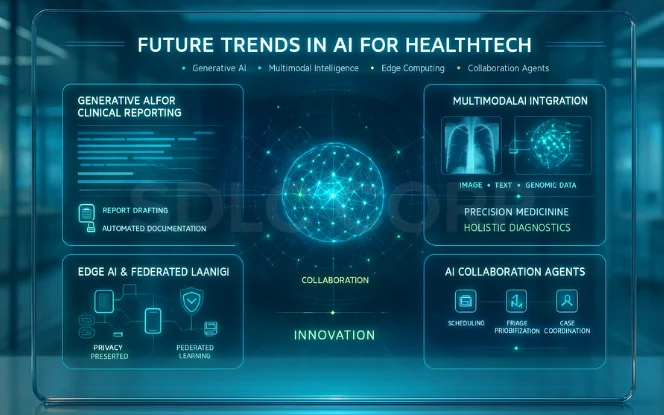
The next decade will see AI for Healthtech advancing beyond prediction and automation into a new age of intelligent, interconnected systems. Emerging innovations are reshaping healthcare delivery with greater personalization, collaboration, and data privacy.
- Generative AI for Clinical Reporting:
Automates medical documentation, producing structured clinical summaries, radiology reports, and discharge notes with human-like accuracy. - Multimodal AI Integration:
Combines images, text, and genomic data to offer holistic diagnostic insights and accelerate precision medicine. - Edge AI & Federated Learning:
Enables local data processing on devices, protecting patient privacy while maintaining performance and compliance with global standards. - AI Collaboration Agents:
Supports care coordination by synchronizing tasks between clinicians, nurses, and administrative teams for better workflow efficiency.
Large healthtech organizations manage AI deployments across multiple facilities, regions, and care pathways. Enterprise-scale platforms centralize analytics while supporting localized workflows. Architectural approaches used by an enterprise AI development company often inform the design of scalable healthtech AI systems.
Advisory and Governance for Healthtech AI
AI systems in healthcare must comply with privacy regulations, clinical guidelines, and ethical standards. Advisory support helps define governance frameworks, audit processes, and usage boundaries. An AI consulting company may assist organizations in aligning AI initiatives with healthcare regulations and best practices.
Conclusion
AI for Agritech is transforming farming through computer vision, predictive analytics, and robotics, enabling higher yields, smarter resource use, and resilient food supply chains. But technology must work alongside farmer expertise and traditional practices. With governments, businesses, and farmers investing in scalable solutions, agriculture can achieve sustainability and global food security. Ultimately, AI for Agritech is not just a trend but a necessity for the future of farming. Explore our AI Development Solution to see how innovation can reshape agriculture for the future.
FAQs
1. What is AI for Healthtech?
AI for Healthtech is the integration of artificial intelligence with health technologies to enhance diagnosis, treatment, and operational efficiency across medical systems.
2. How does AI improve diagnostics?
By applying deep learning and data analytics, AI for Healthtech detects complex patterns in imaging, pathology, and lab results—dramatically improving accuracy, speed, and early disease detection.
3. Is AI for Healthtech safe and compliant?
Yes. When implemented in line with HIPAA, GDPR, and FDA/EMA standards, AI solutions remain secure, ethical, and transparent under well-defined healthcare AI governance frameworks.
4. How can clinics implement AI for Healthtech solutions?
Clinics should start with a pilot program, define measurable KPIs, validate outcomes (like AUC or recall), and scale up through MLOps systems supported by trained interdisciplinary teams.
5. What’s the future of AI for Healthtech?
The next phase will feature generative AI, edge processing, and real-time predictive models advancing personalized medicine and enabling proactive, data-driven healthcare worldwide.



